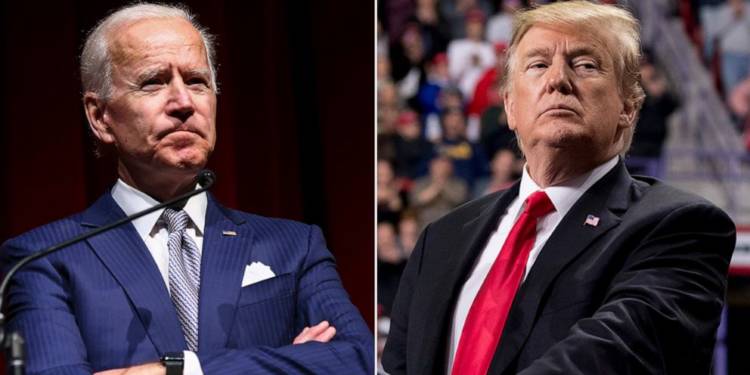As the November Presidential elections are fast approaching, the race to woo the Asian Americans is also heating up in the United States of America. Democrats, who usually hold an edge over this particular demography of voters, seem to be losing their favor as increasing polarization in the wake of the COVID-19 pandemic and President Donald Trump ’s all-out eviscerating attacks on China to protect the American interests have found a lot of takers.
According to a Pew research report, as of 2015, 24% of Asian Americans (4.9 million) were of Chinese origin, the largest single origin group. The next two largest origin groups are Indian-origin Asians, who accounted for 20% of the national Asian population (4.0 million), and Filipinos (19%, or 3.9 million). Those with roots in Vietnam, Korea, and Japan easily clear the 1 million mark as well.
The 74-year-old Donald Trump, who is seeking re-election, is making a big dent into the second biggest vote bank viz. American-Indians, despite the fact that American-Indians have traditionally voted for Democrats in the past.
A report published in India Today states that the Indian-American vote has shifted by 12 percent for President Donald Trump compared to 2016 and was confirmed by a survey released by Prof. Karthick Ramakrishnan, who has tracked Asian American voters over time.
The aggressive stance of some Democrats on the Kashmir issue during last year’s Congressional hearings is being touted as the main reason behind the shift in Indian-American vote towards Republicans.
Republican Indian-Americans say the sharp criticism of India’s Kashmir policies by Democratic Party members on Capitol Hill served as “a wake-up call” for many in the community. It made Indian-Americans reflect on “who was India’s friend and who wasn’t.”
The nomination of Kamala Harris for the Vice President post has also seemingly backfired as her anti-Kashmir remarks last year after the abrogation of article 370 didn’t go down well with the nationalistic American-Indian voters.
“We have to remind the Kashmiris that they are not alone in the world. We are keeping a track on the situation.” Harris had said last year.
As reported previously, 73 percent of American adults hold an unfavorable view of China, which shows a sharp rise of 26 percent from 2018 when 47 percent Americans said that they viewed the Middle Kingdom unfavorably. There has been a rise of 7 percent in unfavorable views since March when Trump started making an election issue out of China.
China is Trump’s major poll plank and it is the common thread that binds most Asian-Americans together. The collective animosity of countries like India, Japan, Vietnam, and the Philippines is the untapped vote bank for Trump, which he is all set to cash on.
The acrimony towards the Chinese by the particular demography is only going to be made more of a poll-issue by Trump as the political turf gets more and more charged.
That fact that the third-largest demography of Asian-American voters is Filipinos can also very well play into Trump’s hand. Off late, the Philippines has been mired in loadful of controversies with China over the water boundaries in the South China Sea. Despite the ruling of an International body in favor of the Philippines, China is not standing back on its claims in the region.
Once Xi Jinping’s biggest admirer, Philippines President Rodrigo Duterte has now turned against him after being constantly provoked by the cumbersome antics of paper-dragon. Reported by TFI, Duterte had even sent a warning to Beijing by saying it will call in the US Navy if China makes a move in the South China Sea.
For the first time, Manila has expressly announced that it would turn to the Pentagon for aid if things get down to the wire. This also marks a complete transformation in the Filipino foreign policy. Manila is therefore going back to its pro-US and anti-China roots by declaring that it has chosen the US over China.
Consequently, Filipino voters are likely to vote, keeping the aforementioned developments in mind.
As for the Japanese-Americans, there is no love lost from them for China. Historically, Japan does not share a pleasant relationship with Beijing. The territorial disputes and World War II embittered grievances have marred the Japan-China relationship for decades. The relations between the two nations are so sour that it can be gauged from the fact that a restaurant owner in China put up a banner that read “Congratulations to the United States for the outbreak of Coronavirus and wish the pandemic lasts forever in Japan”.
Japanese take a lot of pride in their culture and history and Beijing has made sure that the biggest event that Japan was set to host in the new decade—the 2020 Olympics stand scrapped, which has ultimately brought a highly unfavorable view of Chinese. President Donald Trump has stood by Japan and together they both are part of the Quad too.
Trump is expected to polarise the Japanese to his side by the work he has laid down in the past four years.
The Vietnamese are also troubled by the menace of Beijing in its territorial waters. Plus, the selection of a pro-China leader like Joe Biden would mean that Vietnam would lose on the business that it is getting in the aftermath of the Coronavirus pandemic. Essentially meaning, Trump has his foot in the Vietnamese-American door and its only a matter of time that gets the door ajar and collects the precious votes.
Reported by TFI, Biden is already losing some of the swing states due to his hara-kiri policy paper, published in close co-operation with socialist and former democrat nominee Bernie Sanders. Biden’s \ super-ambitious $2 tn four year plan to eliminate all greenhouse gas emissions from the US electricity grid is expected to cause a massive job loss. Swing states like Ohio and Michigan have a combined total of more than 400,000 workers in the shale industry, Pennsylvania has another 320,000. Colorado and Florida each have more than 200,000 workers in oil and gas and they all are set to lose their jobs due to Biden.
An estimated 2.5 million Indians-Americans are eligible to vote in the November polls, out of which 1.3 million of them belong to the battleground states like Ohio, Pennsylvania, Michigan, and Florida. In such states, the victory margins for either party will be needle-thin, and as such, the Indian community will act as a kingmaker. It is, therefore, in the 2020 Presidential elections, crucial for both the parties to try and win over Indian-Americans to secure their seats in the White House.
Joe Biden might not win the elections and despite the poll pundits saying Biden holds an edge over Trump, one cannot help but oversee the general perception. Also, the American media hasn’t been exactly hitting the bull’s eye in gauging public sentiment either. (Read: 2016 elections). Trump has turned the wheel and the Asian-American votes are coming his way indeed.

































